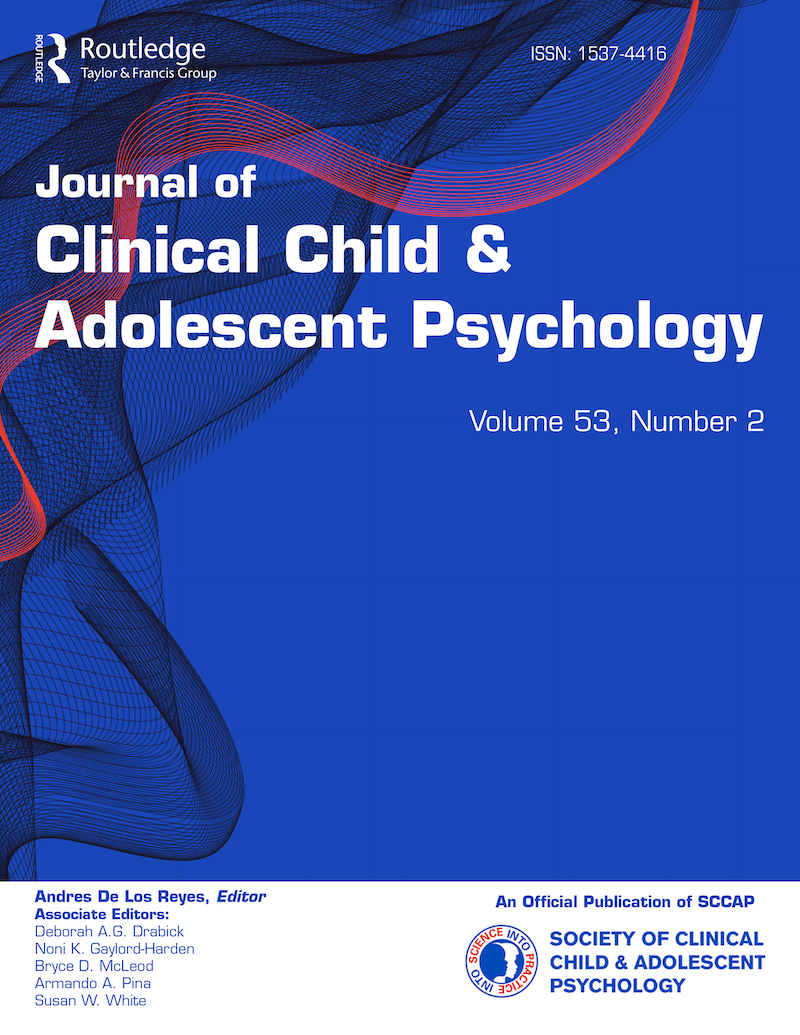2025 Highlights of the Journal of Clinical Child and Adolescent Psychology
2025 Highlights of the Journal of Clinical Child and Adolescent Psychology
By Andres De Los Reyes, PhD
Editor-in-Chief, JCCAP
By Andres De Los Reyes, PhD
Editor-in-Chief, JCCAP
I am excited to report highlights of content from the 2025 volume of the Journal of Clinical Child and Adolescent Psychology.
Evidence Base Updates
We opened this year with an article from our invited series, Evidence Base Updates, that covers the states of the science about psychosocial treatments for youth depression by Weersing and colleagues (https://doi.org/10.1080/15374416.2024.2384022), the abstract of which appears below:
Evidence-Base Update of Psychosocial and Combination Treatments for Child and Adolescent Depression
Weersing, Goger, Schwartz, Baca, Angulo, & Kado-Walton
Objective
This evidence-based update (EBU) builds on three previous reviews (1998, 2008, 2017) sponsored by the Society of Clinical Child and Adolescent Psychology with the aim of evaluating the empirical support for psychosocial interventions for depression in youth.
Method
In the current review period (2014–2022), 25 randomized controlled trials (RCT) were identified: four in children and 21 in adolescents. Descriptive effect sizes and number-needed-to-treat (NNT) ratios were calculated for primary outcomes. Results were integrated with prior reviews, and cumulative evidence used to classify treatments as well-established, probably efficacious, possibly efficacious, or experimental. Published secondary analyses of predictors, moderators, and mediators were examined.
Results
For adolescents, cognitive behavioral therapy (CBT), interpersonal psychotherapy (IPT-A), CBT in combination with antidepressant medication, and collaborative care programs were all classified as well-established. The evidence was considerably weaker for children, with no treatments achieving well-established or probably efficacious status. New developments include greater exploration of parent- and family-mediated treatment models and increasing evidence on technology-assisted interventions. Data on predictors, moderators, and mediators continued to be focused on adolescent depression samples and drawn from a limited number of RCT datasets.
Conclusion
Since the prior EBU, there has been incremental progress in youth depression treatment research. There is an urgent need to: (a) develop innovative approaches to substantially improve on the modest effects seen in most RCTs, (b) expand the evidence base for children and other underserved groups, (c) craft evidence-based guidelines for choosing between interventions when multiple efficacious treatments do exist, and (d) address issues of treatment effectiveness and scalability to ameliorate the wide prevalence and high impact of depression in youth.
Future Directions
This year, we also published articles in our second invited article series, Future Directions, including an insightful piece on next steps of research about youth conduct disorder and psychopathic traits from Salekin and colleagues (https://doi.org/10.1080/15374416.2024.2447240). The abstract appears below:
Future Directions for Conduct Disorder and Psychopathic Trait Specifiers
Salekin, Bellamy, DeGroot, Avellan, Butler, & Grant
Conduct disorder (CD) is a psychiatric diagnosis characterized by a repetitive and persistent pattern of behavior in which the basic rights of others or major age-appropriate social norms or rules are violated. This article presents information on CD with an emphasis on a new multispecifier personality model that could offer a valuable new perspective on CD by refining the way we specify CD. The multispecifier model may have the potential to clarify the considerable confusion that has occurred over past decades and improve our understanding of prevalence, etiology, course, and treatment of youth with conduct problems. In this paper, we present a new structure for CD designed to inspire new lines of research that may be needed to help the field more fully capitalize on this innovation. With additional research, it is hoped that the new multispecifier model will eventually buy clinicians additional information that cannot be gleaned from current diagnostic criteria and will help clinicians and researchers further uncover the factors that promote or protect against the development of CD. This paper delineates the areas of research that will be needed to fully realize the potential of a multispecifier model and ultimately to improve clinical care for children and adolescents with CD.
New Editorial Policy on Measurement Invariance
Lastly, earlier this year we released an editorial highlighting issues surrounding the use (and misuse) of measurement invariance techniques in research about youth mental health, along with a new editorial policy linked to its use (https://doi.org/10.1080/15374416.2025.2484813). A brief synopsis appears below:
Editorial: Fairness, Validity, and Transparency in What Researchers Assume When Testing for Measurement Invariance
De Los Reyes, Oswald, Racz, Pina, McLeod, Wang, & Charamut
Measurement invariance is like any other technique. It carries assumptions: Things you must accept to be true about your data when you apply the technique. If your data meet the technique’s assumptions, then proceed with your measurement invariance tests. Alternatively, if your data violate the assumptions underlying use of measurement invariance, then dire consequences may unfold if you nonetheless proceed with the tests, namely in the loss of validity evidence produced by use of your instrumentation. To address this problem, this editorial frames misuse of measurement invariance as a questionable research practice, akin to p-hacking or HARKing. This facilitates treating this misuse using open science tools, namely a new table that we at JCCAP will require authors to use if they implement measurement invariance tests to address their study aims. Very simple: A transparent statement of the assumptions you made when you applied measurement invariance to your data. Beyond this new tool, the editorial provides a straightforward description of the “who, what, where, when, and why” of measurement invariance.
You can find these and other articles from the journal on our page at Taylor and Francis.
Andres De Los Reyes, PhD
Editor-in-Chief, JCCAP
More From Fall 2025
More From Fall 2025
President’s Column
By Regine Galanti, PhD
In Focus: Youth Suicide
By Julie Cerel, PhD
Expert Recommendations: Perinatal Mental Health
By Colleen Fields, PhD
APA 2025 in Denver: Giant Bear, Distinguished Career, & More
By Sarah Dickinson, PhD & Kelsie Okamura, PhD
The Student View: Updates From the SCCAP Programming Committee
By Katie Moskowitz, Will Morgan, & Annika Quam
Congratulations to Our Student Members on Graduation!
LEADing into the Future with SCCAP LEAD Institute
By Erlanger Turner, PhD & Marilyn Sampilo, PhD, MPH
SCCAP Election Results
SCCAP Seeks Nominations for Upcoming Board Positions
Positions Begin January 1, 2027
JCCAP’s 2025 Highlights
By Andres De Los Reyes, PhD
Update from SCCAP Representatives to APA Council
By Stephen Hupp, PhD & Mary Louise Cashel, PhD
SCCAP Fellows Committee Update
By Martha C. Tompson, PhD
Join Us in Shaping the Future of Membership!
By Nicole Lorenzo, PhD
New Procedures for Joining or Renewing SCCAP Membership!
AIRS SIG Update
By Elisabeth Frazier, PhD
Clinical Child and Adolescent Practice SIG Update
By Megan Lawson, PsyD, ABPP
Summer Treatment Program SIG Update
By Katie Hart, PhD & Sarah Tannenbaum, PsyD, ABPP
More From Fall 2025
More From Fall 2025
President’s Column
By Regine Galanti, PhD
In Focus: Youth Suicide
By Julie Cerel, PhD
Expert Recommendations: Perinatal Mental Health
By Colleen Fields, PhD
APA 2025 in Denver: Giant Bear, Distinguished Career, & More
By Sarah Dickinson, PhD & Kelsie Okamura, PhD
The Student View: Updates From the SCCAP Programming Committee
By Katie Moskowitz, Will Morgan, & Annika Quam
Congratulations to Our Student Members on Graduation!
LEADing into the Future with SCCAP LEAD Institute
By Erlanger Turner, PhD & Marilyn Sampilo, PhD, MPH
SCCAP Election Results
SCCAP Seeks Nominations for Upcoming Board Positions
Positions Begin January 1, 2027
JCCAP’s 2025 Highlights
By Andres De Los Reyes, PhD
Update from SCCAP Representatives to APA Council
By Stephen Hupp, PhD & Mary Louise Cashel, PhD
SCCAP Fellows Committee Update
By Martha C. Tompson, PhD
Join Us in Shaping the Future of Membership!
By Nicole Lorenzo, PhD
New Procedures for Joining or Renewing SCCAP Membership!
AIRS SIG Update
By Elisabeth Frazier, PhD
Clinical Child and Adolescent Practice SIG Update
By Megan Lawson, PsyD, ABPP
Summer Treatment Program SIG Update
By Katie Hart, PhD & Sarah Tannenbaum, PsyD, ABPP


